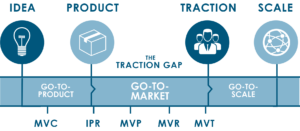To learn more about the Traction Gap Framework, head here.
To get a deeper understanding of the Traction Gap principles, check out these resources:
February 4, 2019
PUBLISHED BY Wildcat Venture Partners
Every successful startup begins with an idea for a new product or service. In the go-to-product phase, significant market research is required to ensure that the idea is intelligently framed and validated. And, while the product and its initial feature set are being validated, successful startup teams must also invest in market engineering exercises to establish a Minimum Viable Category (MVC) by creating and defining a new category or disrupting an existing one.
These are the tasks that all early stage startups must perform in order to develop a “killer” product — and market — from the ground up and prepare themselves to take that product to market.
Once MVC has been established, the next challenge a startup faces in its journey across the Traction GapTM is to reach Initial Product Release (IPR).

IPR is the first point at which the product (often a Beta version) becomes available to the public, and to the target user(s). At this stage, you are on the hunt for market and customer validation metrics demonstrating that your product or service has merit in the marketplace.
Early stage entrepreneurs often make the mistake of being too insular. At IPR, you need to be outward-facing, or as Steve Blank says, “get outside the four walls”. You need to engage with prospective customers or users to test and validate your impressions, instincts, and hunches. You need to actually sit down and speak with some of the people you one day hope will buy your product or service.
This should happen before you spend hours writing code or developing the product, because industry statistics show that more than 70% of products fail (or become “zombies”) early. And the number one cause? No market need. In other words, you may think your product idea is brilliant, sure to be a huge success, but unless you confirm that by asking your hypothetical buyers, you are taking a big risk.
Offsetting this risk means doing proper, statistically-valid market research, before moving into “build mode”. Proper research means not self-selecting for positive responses, not glossing over uncomfortable feedback, and always being willing to adjust in response to constructive criticism. The Wildcat team is constantly exposed to companies that claim to care about market data, but don’t really listen to the data they receive. They prioritize intuition and unrepresentative anecdotes about their customers over what the customer and market feedback is actually telling them.

Capturing customer and market feedback properly can be hard. High-level market research is often beyond the internal skill sets, financial resources, and time-constraints of most established companies, let alone startups. Outside firms are expensive, and the research can take time. Everyone wants to be going to market, yesterday!
But multiple studies show that this attitude is why so many products fail — in fact, according to MIT Sloan, more than 80%. To nail your IPR, you need more than product/market fit, you need market/product fit. Because without a market, there is no need for your product.
Achieving market/product fit requires adopting a market-first mindset. This means that, despite the challenges, you have to find a way to capture useful market data and feedback. You need to discover what drives your potential customers; what they like, don’t like, and what will motivate them to adopt your new product or service.
All of this comes down to the collection and interpretation of market signals. Market signals, from both customers and non-customers, enable you to identify existing and potential problems to be solved. A strong market signal combines what the market says — captured through surveys, focus groups, social media and so on — with what the market actually does. This is valuable intel. However, if you act on weak market signals — a survey that is too small, a few sparse anecdotes — you are setting yourself up to fail.
In summary, a successful IPR requires you and your entire team to develop a market-first mindset and perform proper market research before you begin building anything. This requires discipline and determination. Armed with statistically-validated market and customer data, you will be able to better identify true market signals to guide you rather than depending on just intuition.
……….
To learn more about the Traction Gap Framework, head here.
To get a deeper understanding of the Traction Gap principles, check out these resources:
KEYWORDS